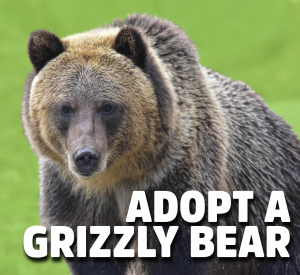Overview
“Where I live”
Brown bears live all across the northern hemisphere and thrive in many types of habitat including forest, taiga, tundra, and coastal and semi-desert areas.
Two subspecies of brown bear live in North America: the grizzly bear and the Kodiak bear. Grizzlies primarily inhabit interior areas of Canada, Alaska, and the continental U.S. (in a handful of northwestern states). Kodiak bears live along the coasts of Alaska and British Columbia and on the nearby Kodiak Islands.
“How I live there”
Brown bears are top-of-the-food-chain predators that feed mostly on berries and nuts. They are shy and retiring by nature but can be dangerous if provoked or taken by surprise. They tend to be solitary animals but are not strictly territorial and sometimes gather in large groups to feed on rich supplies of food.
These giant omnivores roam across enormous home territories in search of food. They have a varied diet that includes nuts, berries, roots, insects, honey, fish, and mammals ranging in size from pocket gophers to moose. Basically, they’ll eat whatever they can find. Of all brown bears, grizzlies are considered the most carnivorous.
Brown bears are diurnal but are most active in early morning and evening. They are also seasonally active, awake for part of the year and asleep for part of the year. To conserve energy, they hibernate during the winter months. They put on massive amounts of weight before retreating into winter dens where they live off of stored fat. While hibernating, a brown bear’s body temperature drops by a few degrees, its heart rate slows, and the bear does not eat, drink, urinate, or defecate. Amazingly, female brown bears give birth and nurse their newborn cubs while hibernating.
“Making my mark”
Despite their name, brown bears are not always brown. They can also appear blonde, almost black, or silver-tipped. Grizzlies are named for the light-tipped fur that gives many a grizzled look. However, just as not all brown bears are brown, not all grizzlies are grizzled.
Generally, female brown bears can weigh up to 550 pounds and males can surpass 1,000 pounds. Kodiak bears are the largest of brown bears. Apart from their huge size, brown bears are also recognized by their prominent shoulder hump, long claws, and “dished” or concave face.
“What eats me”
Brown bears have no predators other than humans. They are most threatened by habitat loss and fragmentation. Historically, they were killed in great numbers by people who considered them a threat to safety and livestock, and they are still killed for these reasons. However, brown bears today are more commonly hunted for sport or for illegal profit. There are several national and international measures in place to protect brown bears, regulate hunting, and ban poaching, but enforcement of laws and other measures varies considerably from country to country.
Raising Young
During brown bear mating season, which lasts for about three months from May to July, males compete for females and may fight to assert dominance. Males and females typically mate with several partners.
Female brown bears, like female polar bears, experience a phenomenon known as delayed implantation. Eggs do not implant into the womb until several months after fertilization. As winter approaches, females in good physical shape are more likely to achieve implantation and become pregnant.
Conservation
Because of their large overall population and wide range across the northern hemisphere, brown bears are considered a relatively stable species. The IUCN, the world’s leading conservation organization, lists them as a species of “least concern.” However, while some populations are stable and expanding, others are small, fragmented, and in danger of disappearing. This is true of populations in Europe and the continental U.S.
Grizzlies, a North American subspecies of brown bear, are primarily found in interior parts of Canada, Alaska, and the continental U.S. While they exist in greater numbers north of the U.S.-Canada border, grizzlies have been listed as a threatened species within the continental U.S. since 1975 under the federal Endangered Species Act. According to the U.S. Fish and Wildlife Service, there are six areas in the lower 48 states where grizzlies still live: the Yellowstone ecosystem (northwest Wyoming/southern Montana), Bitterroot ecosystem (central Idaho/western Montana), Northern Continental Divide ecosystem (northwestern Montana), Cabinet-Yaak ecosystem (northern Idaho/northwest Montana), Selkirk ecosystem (northern Idaho/northwest Washington), and Northern Cascades ecosystem (north-central Washington/south-central British Columbia).
The Yellowstone population of grizzlies has recovered enough to now be considered for de-listing. However, other American grizzly populations are still considered threatened. Efforts to conserve grizzlies in the continental U.S. are ongoing and have met with some success over the past 40 years due to close cooperation among relevant organizations and state agencies known as the Interagency Grizzly Bear Committee. The IGBC coordinates habitat management, research, education, and outreach.
*Within the continental U.S., grizzly bears, a North American subspecies of brown bear, are listed as threatened by sub-population under the federal Endangered Species Act.
Taxonomy
- Kingdom: Animalia
- Phylum: Chordata
- Subphylum: Vertebrata
- Class: Mammalia
- Order: Carnivora
- Family: Caniformia
- Genera: Ursus
- Species: arctos



